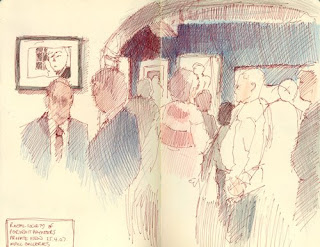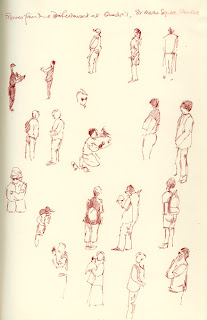Saturday, May 16, 2009
10 tips sketching people
Do you like this story?
Above are the tips in sketching people
These tips are NOT of the 'get rich quick' variety. They're essentially principles which make much more sense through application. However the real benefits really only come when they become ingrained habits through lots of practice.
#1. Take a class in life drawing!
This is my #1 top tip because this one tip produces the most benefit in terms of learning how to look, understanding how the human body works and how to draw figurative shapes and values.
There's no point in making life difficult for yourself. Sketching people who are settled or who move only a little or slowly makes sketching people a lot easier.
Here are some suggestions:
- cafes, bars and restaurants,
- waiting rooms of any kind
- train stations and airports
- art galleries
- people watching an event
- parks and places where people sit in the sun
- artists sketching/drawing/painting plein air or in studios
There's no way of getting round this one! Tips on how to sketch quickly can be found in Sketching for Real: Assignment 1 - So you want to learn how to sketch...... Also learn to be philosophical about the fact that you'll have a lot of "starts" which don't go anywhere in your sketchbook. My rule of thumb is I lose about 25% of the sketches I start - and I draw very fast!
#4. Sit in one place and construct a scene
So - you've accepted that people will come and go so and you've learned how to sketch quickly. You still need a strategy for how to deal with the comings and goings. My own personal strategy is to sit in one place and construct a scene around a pivotal person.
 I try and select somebody who looks interesting and as if they might stay still long enough for me to get the bare essentials down - size, shapes, relationship with the background and, in particular, the horizontals and verticals. I then construct the scene around that person as people come and go. They don't all have to be there at the same time!
I try and select somebody who looks interesting and as if they might stay still long enough for me to get the bare essentials down - size, shapes, relationship with the background and, in particular, the horizontals and verticals. I then construct the scene around that person as people come and go. They don't all have to be there at the same time!Remember you are sketching and not drawing a portrait. I've noticed a tendency for people who are starting to sketch to just sketch individuals as isolated objects and for them to ignore the backgrounds and context altogether. The next three tips are about addressing this.
#5. Draw shapes and values not detail
Squint to see values. Start by working out the rough size and shape of the big shapes that you can see - in value terms. You can then work within these - again using value shapes. Using line to describe the edge of some aspect of detail can then be surprisingly effective if most of the drawing is value shapes due to the contrast between the two. I always enjoy sketching the 'squiggley' bits of folds in clothing.
#6. Make connections.
Here are some of the connections you can make
- look for connections between people in terms of relationships and body language
- identify the big shape that is the group of people. If you can't see an edge then don't draw it.
- join up shapes which are the same value e.g. connect shapes associated with an individual to the background if they are the same value
- make the connections between different zones more obvious. Overlap figures and objects to demonstrate who is in the foreground, the middle ground and background.
Use the background to help with scale. Sight size and measure proportions accurately if you have the time If you don't, then choose one line to act as a baseline for keeping everything in proportion. I always try and find a vertical because I have a tendency to have leaning verticals and it acts as a check.
#8. Seek out repetition.
People who repeat movements are good subjects to draw. You have to work out what the sequence is and how often it repeats. Artists very often make wonderful models for learning how to draw people who are animated as most tend to have a neat and repetitive routine of movements when drawing or painting. The painter in the above sketch had two distinct patterns of movements. I watched for a while and decided which one gave maximum sketching time.
#9. Avoid drawing faces and feet!
If you draw a likeness, then you should really obtain a model release. Practice likenesses with family and people you know rather than with strangers. Squint when you look at faces and then only draw what you can see - which will be values. You'll be surprised at how little detail there is.
Feet are often drawn bigger than they actually are. Check the feet in the sketch below - would you have drawn them this small?
 #10. This is not an exercise in portraiture. It's worth reiterating that you need to remember that you are sketching and not drawing a portrait or trying to be wholly accurate.
#10. This is not an exercise in portraiture. It's worth reiterating that you need to remember that you are sketching and not drawing a portrait or trying to be wholly accurate.Think of yourself as a visual journalist, there to record what you see - when you squint! Be discriminating - you don't need to draw everything. A lot of people's sketches are not complete.
If you get a good vantage point, try drawing lots of little people on one sheet of paper. Drawing small is always interesting as you have to work out what are the important characteristics to keep which mean they don't all look like stick men or the same. You can also change the colour of clothing to make sketches better!

This post was written by: beemagnet77
BeeMagnet is a professional graphic designer, web designer and business man with really strong passion that specializes in marketing strategy. Usually hangs out in Twitter has recently launched a blog dedicated to home design inspiration for designers, bride, photographers and artists called HomeBase












0 Responses to “10 tips sketching people”
Post a Comment